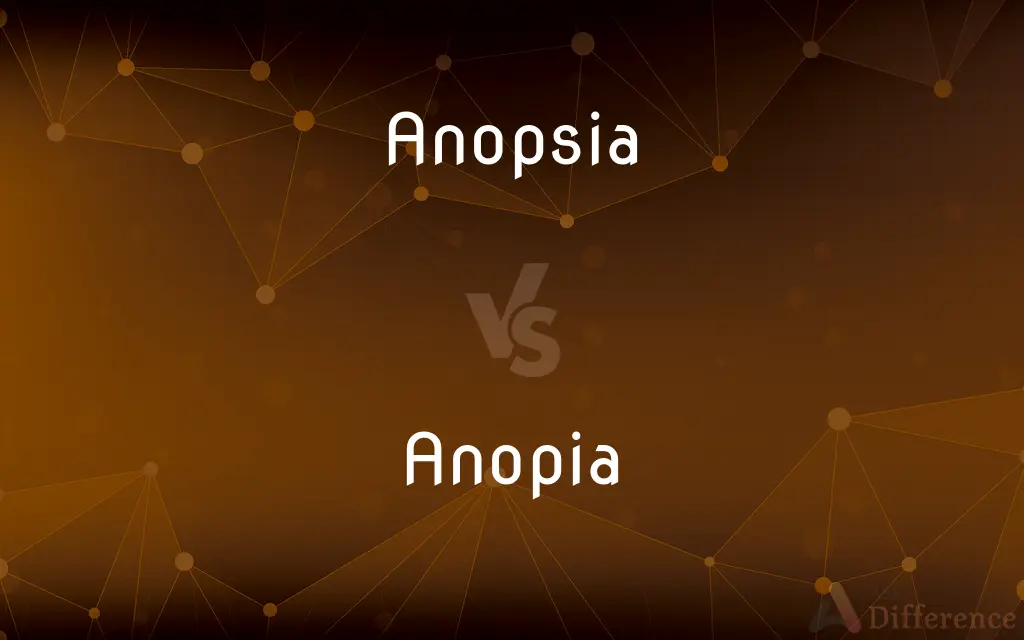Anopsia vs. Anopia — What's the Difference?
By Tayyaba Rehman — Updated on November 2, 2023
Anopsia refers to blindness, especially in one half of the visual field, whereas anopia generally means the absence of eyes.

Difference Between Anopsia and Anopia
Table of Contents
ADVERTISEMENT
Key Differences
Anopsia is a medical term used to describe a condition that results in a loss of vision, specifically in one half of the field of vision, known as hemianopsia. It is a type of visual impairment that can result from various causes, such as brain injury, stroke, or neurological disorders. Anopia, by contrast, is a rarer term that is sometimes used to describe the congenital absence of eyes, a condition also known as anophthalmia.
The term anopsia often implies a partial or complete loss of vision that may affect one or both eyes, depending on the extent and location of the brain or eye damage. Anopia, on the other hand, is usually associated with a developmental anomaly where the eyes are either absent or severely underdeveloped from birth. Anopsia can be acquired due to external factors, whereas anopia is typically a congenital condition.
Anopsia can manifest in different forms, such as quadrantanopsia, where a quarter of the visual field is lost, or hemianopsia, where half of the visual field is lost. Each type of anopsia reflects the specific region of visual processing that is affected. In contrast, anopia is not classified by degrees or areas of vision loss because it pertains to the absence of the organ itself rather than the loss of visual field.
Medical management and prognosis for patients with anopsia may vary, focusing on rehabilitation and adaptation to the vision loss. For individuals with anopia, medical intervention may include the use of prosthetic eyes or surgery, with a focus on cosmetic restoration and potential integration of assistive technologies, as there is no vision to be rehabilitated.
In the context of medical terminology and patient care, it is crucial to differentiate between anopsia and anopia due to their distinct implications for treatment and patient support. While both terms describe serious visual impairments, the causes, treatments, and patient experiences of anopsia and anopia are uniquely different.
ADVERTISEMENT
Comparison Chart
Definition
Loss of vision in one half of the visual field.
Congenital absence of eyes.
Etiology
Caused by damage to the brain or optic pathways.
A developmental disorder present at birth.
Classification
Classified by affected visual field (e.g., hemianopsia).
Not applicable as it involves absence of the organ.
Implications for Treatment
Focus on rehabilitation and adaptation strategies.
Focus on cosmetic restoration and assistive devices.
Prognosis
May vary based on cause and extent of brain injury.
Cosmetic correction possible, but no potential for vision recovery.
Compare with Definitions
Anopsia
Visual impairment in part of the visual field.
After the accident, the patient experienced anopsia, affecting his left visual field.
Anopia
A medical term for being born without eyes.
Cases of anopia may involve complex genetic counseling.
Anopsia
A neurological condition causing partial blindness.
Anopsia has made reading difficult for her without special aids.
Anopia
The absence of eyes since birth.
The child was born with anopia and uses a prosthetic eye.
Anopsia
A symptom indicating occipital lobe injury.
The neurologist diagnosed anopsia, suggesting occipital lobe involvement.
Anopia
A congenital condition resulting in no eye formation.
Anopia is a rare condition that can impact facial development.
Anopsia
Hemianopic visual loss.
Anopsia in patients often requires the use of vision therapy.
Anopia
A developmental disorder characterized by an absence of ocular organs.
Surgeons created a socket for a prosthetic due to the patient's anopia.
Anopsia
Loss of vision due to brain damage.
His anopsia was the result of a stroke.
Anopia
The lack of eye development in a fetus.
Anopia was detected in the ultrasound during the second trimester.
Anopsia
An anopsia is a defect in the visual field. If the defect is only partial, then the portion of the field with the defect can be used to isolate the underlying cause.
Anopia
(medicine) State or condition of sightlessness, often due to medical reasons.
Anopsia
(ophthalmology) A defect in the visual field
Anopia
Sightlessness (especially because of a structural defect in or the absence of an eye)
Anopsia
Want or defect of sight; blindness.
Common Curiosities
Is anopsia a permanent condition?
Anopsia can be permanent, but some cases may see partial improvement depending on the cause.
What causes anopia?
Anopia is usually caused by genetic mutations or developmental issues during pregnancy.
Does anopia affect other parts of the body?
Anopia can be part of a syndrome affecting other parts of the body, depending on the underlying cause.
What does anopia mean?
Anopia refers to the congenital absence of one or both eyes.
What is anopsia?
Anopsia is a condition where there is a partial or complete loss of vision, particularly in one half of the visual field.
How is anopsia diagnosed?
Anopsia is diagnosed through visual field tests and neurological examinations to identify the affected areas of vision.
Can anopia be treated?
Anopia cannot be treated to restore vision; treatment is usually cosmetic, such as with prosthetic eyes.
What is the difference between anopsia and blindness?
Anopsia refers specifically to loss in part of the visual field, whereas blindness can refer to complete loss of vision.
Can anopia occur later in life?
Anopia is a congenital condition, so it does not occur later in life but is present at birth.
Are there different types of anopsia?
Yes, there are several types, including hemianopsia and quadrantanopsia, classified by the area of vision loss.
Can anopsia occur in both eyes?
Yes, anopsia can affect both eyes, although it often impacts just one side of the visual field for both.
Is anopia hereditary?
Some forms of anopia can be hereditary, while others may occur sporadically.
Are people with anopsia legally blind?
Depending on the severity and location of the vision loss, individuals with anopsia may be considered legally blind.
How is anopia detected?
Anopia is usually detected at birth or through prenatal imaging techniques.
What support is available for individuals with anopsia?
Support can include vision rehabilitation services, assistive technology, and community resources for the visually impaired.
Share Your Discovery

Previous Comparison
Tare vs. Tear
Next Comparison
Border vs. BoarderAuthor Spotlight
Written by
Tayyaba RehmanTayyaba Rehman is a distinguished writer, currently serving as a primary contributor to askdifference.com. As a researcher in semantics and etymology, Tayyaba's passion for the complexity of languages and their distinctions has found a perfect home on the platform. Tayyaba delves into the intricacies of language, distinguishing between commonly confused words and phrases, thereby providing clarity for readers worldwide.
















































